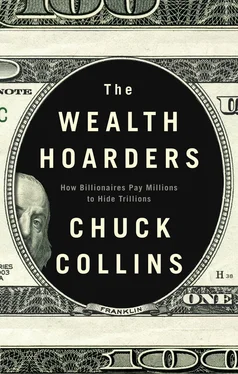We will discuss in more detail the central role of trusts in hiding wealth. But the important thing to understand is how Rensin’s trust created a fictional legal “ownership limbo,” where a grifter like Rensin could argue that he was not technically and legally the owner of the assets in the trust. Such a trust exists to frustrate people and governments trying to hold someone like Rensin accountable for their actions, whether they are creditors, tax authorities, law enforcement officials, or former spouses.
Over the ensuing years, as creditors and the government pursued Rensin, he was well armored, deploying some of the most aggressive wealth hiding and asset protection strategies available in addition to his offshore trusts. He moved to Florida, purchasing a mansion with a “homestead exemption” that protected that asset from claims. He declared corporate and personal bankruptcy. He transferred funds in and out of his asset protection trusts in the Cook Islands. When authorities attempted to seize funds from his offshore trusts, he shifted the trustee from the Cook Islands to the dodgy debtor haven of Belize. His wealth defenders then went to the Belize Supreme Court and secured a judgment that the Belize trustee was not to honor any order of a US court to turn over the assets. During this time, Rensin lived the high life. He defied court orders to compensate customers, using his assets instead to finance a luxurious lifestyle, include spending on travel, hotels, restaurants, and fancy cars. He sold two houses in Maryland and bought a home in Florida. As trust lawyer Gray Edmondson observed:
Rather than downsizing, he continued to occupy a 5,000 square foot mansion, paid for in cash that rightfully belongs to his defrauded victims. And the contempt proceeding did not curb Rensin’s spending. Just three weeks after the contempt hearing and three weeks before he filed for bankruptcy, Rensin bought himself a brand new Lexus. 4
Years passed with the FTC and Bankruptcy trustee trying get a nickel out of Rensin. In February 2019, the Southern District of Florida ruled that Rensin could not hide behind a bankruptcy filing to shield himself from complying with a contempt order requiring him to pay $13.4 million for violating an FTC order. But Rensin was two steps ahead of the law. The Joren Trust, with its trustee in Belize, purchased several annuities that are exempt from creditors as per the general rule in Florida. But isn’t this a fraudulent transaction, shifting funds while being pursued by the law? The legal game of cat and mouse continues. Lawyers and specialists in the field of wealth preservation are analyzing the case for its lessons and implications. 5
Fifteen years after those television ads, thousands of Blue Hippo customers are still waiting for their money back. Meanwhile, as of this writing, Joseph Rensin is living in his home in Wellington, Florida. He posts pictures of his new puppy on Facebook, along with memes from rightwing political groups. 6Rensin’s LinkedIn profile describes him currently as CEO of AGX Funds, a private equity fund. His profile states that between February 2001 and January 2010, he was Chairman and CEO of Edison Worldwide, the owners of BlueHippo. His profile claims, “Edison was the largest direct response merchandise lender in the United States. Over 250 employees, several hundred thousand customers and over $300 million revenue. We spent tens of millions of dollars on national TV, radio and print advertising and had multiple call centers in the US and worldwide.” 7
Why is it so hard to hold fraudsters like Joseph Rensin accountable? Why has Rensin never spent time in jail for willfully fleecing tens of thousands of customers while a repeat-offender shoplifter serves jail time? Consider the millions of people, disproportionately black and brown, caught up in the US criminal justice system for lesser crimes. And consider the victims of Rensin’s scams, mostly low-income working people, with Blue Hippo raiding their bank accounts. Rensin could not have pulled off his multi-million-dollar rip-off without the assistance of a professional Wealth Defense Industry. How could Rensin, sitting in Maryland in 2001, create a trust in the Cook Islands? Who designed the “asset protection trusts” where someone could be both the settlor and the sole beneficiary? Who advised him to shift the trusteeship to Belize, with its pliable court system, to protect the funds of the trust?
Who were the lawyers, accountants, and wealth advisors who enabled Rensin along the way? How much money did they make creating these wealth protection schemes and defending them? Do they have any ethical obligation to prevent what happened? Are they members of professional associations that have codes of conduct? What are these associations doing to ensure that the next Joseph Rensin, a swindler who acts with impunity, can’t repeat what he did? Why couldn’t he be stopped?
1 1. Among several consumer bulletin boards. https://farmanor.blogspot.com/2005/11/bluehippo-rip-off.htmland http://www.mozillaquest.com/Hardware05/BlueHippo_Computer_Ripoff_Story01.html
2 2. https://www.hostobuchan.com/
3 3. Erik Eckholm, “Enticing Ad, Little Cash and Then a Lot of Regret,” New York Times, July 14, 2007. https://www.nytimes.com/2007/07/14/us/14scam.html
4 4. Remarks by Gary Edmundson on a podcast, “Update of Asset Protection Trust Litigation,” produced by the American College of Trust and Estate Counsel (ACTEC), Trust and Estate Talk Podcast, December 2019. https://actecfoundation.org/podcasts/asset-protection-trust-update/Many of these details are spelled out in court documents: https://www.ftc.gov/system/files/documents/cases/bluehippo-rensin_ca2_ftc_brief_final_2017-0710.pdf
5 5. For an especially comprehensive assessment of the case, see Jay Adkisson, “Annuity Payments Protected from Creditors in Rensin,” Forbes, June 19, 2019. https://www.forbes.com/sites/jayadkisson/2019/06/19/annuity-payments-protected-from-creditors-in-rensin/#154cdb522f3f
6 6. https://www.facebook.com/joe.rensin
7 7. https://www.linkedin.com/in/joseph-rensin-85021a13/
Prelude 2020 The Theft of Angola
Pedro Alexandrino stood on the site of his former home, a once-thriving fishing village south of Luanda, the capital city of Angola, on the coast of West Africa. “It’s all gone. Nothing is left,” Alexandrino told the journalist Juliette Garside, looking over a bulldozed spit of land of sand and gravel. “Now we are living in horrible conditions.” 1
Alexandrino’s village, once on a sand bar called Areia Branca, was unfortunately coveted by the Angolan government of then-President Jose Eduardo dos Santos for a very different vision. Inspired by the man-made coastal islands of Dubai, the dos Santos government developed a master plan to construct a new coastal corridor of luxury homes, a commercial district, parks, and a new fishing port. Overseeing this development plan, called the Marginal da Corimba, were a number of quasi-public and private corporations that stood to benefit enormously from the redevelopment process. These included Urbinveste, owned and controlled by the daughter of Angola’s president, Isabel dos Santos.
On June 1, 2013, the 3,000 residents of Areia Branca were forcibly evicted by police and the presidential guard to make way for the government’s redevelopment scheme. “We had no warning at all of what was going to happen,” said Alexandrino. He had come home from work on a Friday afternoon and gone to bed around 11 pm. At 2 am he heard the noise and saw the soldiers and police moving to destroy the houses of the village. Those who resisted were beaten. Residents scattered and many moved to a squatter encampment on a former waste dump across the lagoon from their former village, building 500 tiny shacks of corrugated tin. Here they attempt to survive, living in horrible conditions that are rife with infectious diseases, including malaria, tuberculosis, and meningitis.
Читать дальше











